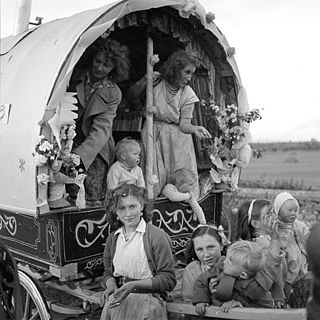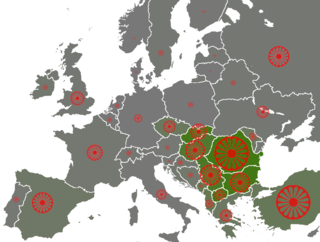Gallery
- Bede family in polythene tents
- Bede man with snake
- Group of Bedenis
Bede (famine: Bedeni) or Bedey, also known as Manta, is an Indo-Aryan nomadic ethnic group of Bangladesh. [1] The Bede traditionally live, travel, and earn their living on the river, which has given them the name of "Water Gypsy" or "River Gypsy". [2] Bedes are similar to European gypsies. [3] They travel in groups and never stay in one place for more than a couple of months. The Bedes are a marginalized group. About 98% of Bedes live below the poverty line, and about 95% of Bede children do not attend school. Historically the Bedes were unable to vote as they did not own land, nor could they apply for banks loan or microcredit for the same reason. [4]
The majority of the Bedes live on snake related trading, such as snake charming (training), snake catching, snake selling, etc. They also sell lucky heathers and herbal medicines, which they claim have magical properties. Bedes' other occupations are in the entertainment services (e.g. monkey shows, magic shows) and petty trading. [2] Many villagers believe in the magical powers of the gypsies. They can make evil spirits leave someone's body according to magical powers. Some of them beg on the busy streets of big cities like Dhaka, Chittagong, Khulna.
Bedes do not have any kind of formal education and they do not use medical facilities. Most of them speak Bengali. Most of them are Muslim but also practice Hinduism, Shamanism and Animism along with Islam. They are related to other South Asian nomadic groups, such as the Dom and Buno people.

The Romani, also spelled Romany or Rromani and colloquially known as the Roma, are an ethnic group of Indo-Aryan origin who traditionally lived a nomadic, itinerant lifestyle. Linguistic and genetic evidence suggests that the Romani originated in the Indian subcontinent, in particular the region of present-day Rajasthan. Their subsequent westward migration, possibly in waves, is now believed by historians to have occurred around 1000 CE. Their original name is from the Sanskrit word डोम, ḍoma and means a member of the Dom caste of travelling musicians and dancers. The Roma population moved west into the Ghaznavid Empire and later into the Byzantine Empire. The Roma are thought to have arrived in Europe around the 13th to 14th century. Although they are widely dispersed, their most concentrated populations are located in Bulgaria, Hungary, Romania, Spain, and Turkey.

Irish Travellers, also known as Pavees or Mincéirs are a traditionally peripatetic indigenous ethno-cultural group originating in Ireland.

Nomads are communities without fixed habitation who regularly move to and from areas. Such groups include hunter-gatherers, pastoral nomads, tinkers and trader nomads. In the twentieth century, the population of nomadic pastoral tribes slowly decreased, reaching an estimated 30–40 million nomads in the world as of 1995.

The Moken are an Austronesian people of the Mergui Archipelago, a group of approximately 800 islands claimed by both Myanmar and Thailand, and the Surin Islands. Most of the 2,000 to 3,000 Moken live a semi-nomadic hunter-gatherer lifestyle heavily based on the sea, though this lifestyle is increasingly under threat.

New Age Travellers are people located primarily in the United Kingdom generally espousing New Age beliefs with hippie or Bohemian culture of the 1960s. New Age Travellers used to travel between free music festivals and fairs prior to crackdown in the 1990s. New Traveller also refers to those who are not traditionally of an ethnic nomadic group but who have chosen to pursue a nomadic lifestyle.

Snake charming is the practice of appearing to hypnotize a snake by playing and waving around an instrument called a pungi. A typical performance may also include handling the snakes or performing other seemingly dangerous acts, as well as other street performance staples, like juggling and sleight of hand. The practice was historically the profession of some tribesmen in India well into the 20th century but snake charming declined rapidly after the government banned the practice in 1972. Snake-charmer performances still happen in other Asian nations such as Pakistan, Bangladesh, Sri Lanka, Thailand and Malaysia. The tradition is also practiced in North African countries of Egypt, Morocco, and Tunisia.

Romanichals are a Romani subgroup within the United Kingdom and other parts of the English-speaking world. Most Romanichal speak Angloromani, a mixed language that blends Romani vocabulary with English syntax. Romanichals resident in England, Scotland, and Wales are part of the Gypsy, Roma, and Traveller community.

The Lyuli, Jughi or Jugi are a branch of the Ghorbati people living in Central Asia, primarily Tajikistan, Uzbekistan, Turkmenistan, Kazakhstan, and southern Kyrgyzstan; also, related groups can be found in Turkey, and the Balkans, Crimea, Southern Russia and Afghanistan. They speak ethnolects of the Persian and Turkic language and practice Sunni Islam. The terms Lyuli and Jugi are considered pejorative. They have a clan organization. Division into sub-clans is also practiced. The Lyuli community is extremely closed towards non-Lyuli.

The Romani people have several distinct populations, the largest being the Roma and the Calé, who reached Anatolia and the Balkans in the early 12th century, from a migration out of the Indian subcontinent beginning about 1st century – 2nd century AD. They settled in the areas of present-day Turkey, Greece, Serbia, Romania, Croatia, Moldova, Bulgaria, North Macedonia, Hungary, Albania, Kosovo, Bosnia and Herzegovina, Czech Republic, Slovenia and Slovakia, by order of volume, and Spain. From the Balkans, they migrated throughout Europe and, in the nineteenth and later centuries, to the Americas. The Roma population in the United States is estimated at more than one million.

Raute are a nomadic traveling ethnic group officially recognized by the Government of Nepal. They are known for subsistence hunting of langur and macaque monkeys. They gather wild forest tubers, fruits, and greens on a regular basis. To obtain grain (rice), iron, cloth, and jewelry, they carve wooden bowls and boxes to trade for goods from local farmers. They do not sell other forest products, bushmeat, or forest medicinal plants. Raute do not share their language, hunting strategies and worship practices to the villagers to maintain their cultural purity. These days, they are accepting gifts and allowances from the government and non-government organizations in regular basis.
Polska Roma are the largest and one of the oldest ethnolinguistic subgroups of Romani people living in Poland. Some Polska Roma also live in North America, Switzerland, Sweden, Great Britain and countries of the European Union. The term "Polska Roma" is both an ethnonym of the group and a term used in the academic literature. As such it is distinct from the terms "Polish Roma" or "Roma in Poland" which better denote the broader Roma population in Poland. Polish ethnographer Jerzy Ficowski, writing in the 1950s and 1960s used the term "Polish Lowlander Gypsies" to refer to the same group, though this terminology is no longer in widespread use.

The Kucong are an ethnic group in China. They are considered one of the poorest minorities in the country. There are around 80,000 Kucong people, living primarily in the Mojiang, Xinping, and Mengla counties of China's Yunnan Province. Some live in Thailand, Myanmar, Vietnam, Laos, and the United States, where at least 600 are living as migrants.
There are several ethnic groups in Afghanistan which traditionally lead a peripatetic life. This means they are nomadic and their main occupations centre around providing services to the settled populations they travel among, like peddling particular goods or performing music. In this way, they contrast both with the settled population and with the pastoralist nomads. They are of low social status and are known to outsiders as Jats, a derogatory term that none of the groups use as a self-designation.
Romani Americans are Americans who have full or partial Romani ancestry. It is estimated that there are one million Romani people in the United States. Though the Romani population in the United States has largely assimilated into American society, the largest concentrations are in Southern California, the Pacific Northwest, Southwestern United States, Texas, Louisiana, Florida and the Northeast as well as in cities such as Chicago and St. Louis.

There are a number of traditionally itinerant or travelling groups in Europe who are known as Travellers or Gypsies.

The Romani people in Australia are citizens of Australia who are of Romani descent. They are sometimes referred to as Roma. Most Roma in Australia trace their roots to the United Kingdom and Greece, who in return trace their roots to northern India.
Nagmoti is a 1983 Indian Bengali film directed by Gautam Chattopadhyay and produced by Sibaprasad Sen, starring Atanu Roy, Joy Banerjee and Sreela Majumdar in the lead roles. The screenplay and the musical score was also written by Gautam Chattopadhyay. The cinematographer of the film was Vivek Banerjee. The Director of audiography was Durga Das Mitra. The editor of the film was Bulu Ghosh.
The oldest settled group are the Kovači (Blacksmiths), a subgroup of the Arlije, who have lived there since the Middle Ages and who converted to Islam during the Ottoman period, they do not speak Balkan Romani, but rather Montenegrin language or Albanian language, they live especially in the towns of Bar, Montenegro and Ulcinj. They do not want to be called Roma and distance themselves from other Roma groups. They have no roma traditions. They call themselves only as Muslims.

White: Gypsy or Irish Traveller is an ethnicity classification used in the 2011 United Kingdom Census. In the 2011 census, the White: Gypsy or Irish Traveller population was 63,193 or about 0.1 per cent of the total population of the country. The ethnicity category may encompass populace from the distinct ethnic groups of Romanichal Travellers or Irish Travellers, and their respective related subgroupings, who identify as, or are perceived to be, white people in the United Kingdom.
Gypsy, Roma and Traveller is an umbrella term used in the United Kingdom to represent several diverse ethnic groups which have a shared history of nomadism. The groups include Gypsies, defined as communities of travelling people who share a Romani heritage, resident in Britain since the 16th century; Ethnic Travellers, the traditional travelling people of Ireland and Scotland; and Roma, who are defined as recent Romani migrants from Eastern Europe. Although these groups' traditional lifestyles involved travel, most GRT people now live in houses or permanent caravan berths.